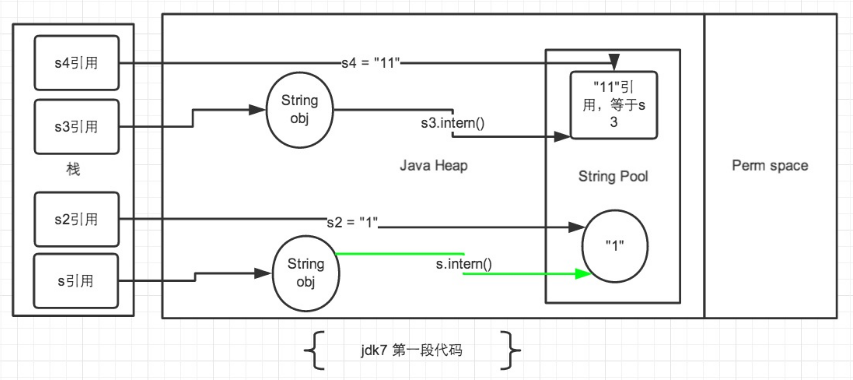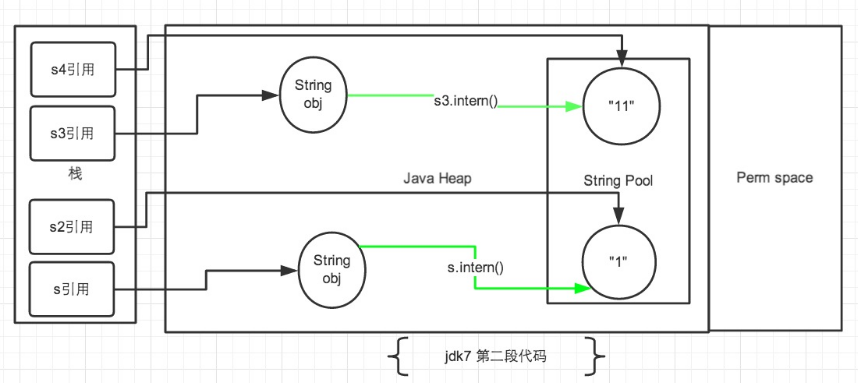JDK原始碼學習筆記——String
1、學習jdk原始碼,從以下幾個方面入手:
類定義(繼承,實現介面等)
全域性變數
方法
內部類
2、hashCode
private int hash;
public int hashCode() { int h = hash; if (h == 0 && value.length > 0) { char val[] = value; for (int i = 0; i < value.length; i++) { h= 31 * h + val[i]; } hash = h; } return h; }
為什麼是31?
(1)計算hashcode值一般選質數
(2)太小的數計算的hashcode值衝突率高,太大的數乘法計算會溢位int範圍
(3)有以上兩點和實驗得 出:31, 33, 37, 39 ,41 作為乘子比較合適
(4)這幾個數字中31的乘法運算可以被優化:31 * i == (i << 5) - i
3、構造兩種:
(1)直接將otherStr引用給this
(2)陣列copy
4、String對“+”的支援
public static void main(String[] args) { String s1="a" + "b";// 編譯之後 String s1 = "ab"; String s = "a"; String s2= s+ "b";// 編譯之後 String s = (new StringBuilder(String.valueOf(s))).append("b").toString(); }
5、jdk1.7修改subString()
// jdk1.6 String(int offset, int count, charvalue[]) { this.value = value; this.offset = offset; this.count = count; } // subString方法部分 return ((beginIndex == 0) && (endIndex == count)) ? this : new String(offset + beginIndex, endIndex - beginIndex, value); // jdk1.7 public String(char value[], int offset, int count) { . . . this.value = Arrays.copyOfRange(value, offset, offset+count); } // subString方法部分 return ((beginIndex == 0) && (endIndex == value.length)) ? this : new String(value, beginIndex, subLen);
jdk1.6的substring:
(1)直接將引用賦值,效能好,共享內部陣列節約記憶體
(2)由於原String的value是private final,可以保證安全性
(3)可能導致記憶體洩漏
String aLongString = "...a very long string..."; // 很長 String aPart = data.substring(2, 4); return aPart;
假設從一個很長的字串中提取一小段內容:
當aLongString不再使用,aPart繼續使用時,
aLongString被回收,aLongString的value還被aPart的value引用,不能被回收
導致記憶體洩漏
6、程式設計技巧學習
/** * 先比較是否同一個物件 * 先比較長度 * 雖然程式碼寫的內容比較多,但是可以很大程度上提高比較的效率 */ public boolean equals(Object anObject) { if (this == anObject) {// 先比較是否同一個物件 return true; } if (anObject instanceof String) { String anotherString = (String)anObject; int n = value.length; if (n == anotherString.value.length) {// 先比較長度 char v1[] = value; char v2[] = anotherString.value; int i = 0; while (n-- != 0) { if (v1[i] != v2[i]) return false; i++; } return true; } } return false; }
static int indexOf(char[] source, int sourceOffset, int sourceCount, char[] target, int targetOffset, int targetCount, int fromIndex) { if (fromIndex >= sourceCount) { return (targetCount == 0 ? sourceCount : -1); } if (fromIndex < 0) { fromIndex = 0; } if (targetCount == 0) { return fromIndex; } char first = target[targetOffset]; int max = sourceOffset + (sourceCount - targetCount); for (int i = sourceOffset + fromIndex; i <= max; i++) { /* Look for first character. 先比較第一個字元*/ if (source[i] != first) { while (++i <= max && source[i] != first); } /* Found first character, now look at the rest of v2 */ if (i <= max) { int j = i + 1; int end = j + targetCount - 1; for (int k = targetOffset + 1; j < end && source[j] == target[k]; j++, k++); if (j == end) { /* Found whole string. */ return i - sourceOffset; } } } return -1; }
/** * 三目運算子代替多個if */ public boolean equalsIgnoreCase(String anotherString) { return (this == anotherString) ? true : (anotherString != null) && (anotherString.value.length == value.length) && regionMatches(true, 0, anotherString, 0, value.length); }
7、intern()
(1)String s = new String("abc");建立個幾個物件
類載入時建立"abc"放入常量池 第一個
執行程式碼時new String() 第二個
(2)String存入常量池方式:
一,直接使用雙引號宣告出來的String物件,在類載入時會直接儲存在常量池中。
二,如果不是用雙引號宣告的String物件,可以使用String提供的intern方法。
intern 方法:
如果常量池中存在當前字串, 就會直接返回當前字串。 如果常量池中沒有此字串, 會將此字串放入常量池中後,再返回。
(3)jdk6 和 jdk7 下 intern 的區別
在 JDK1.2 ~ JDK6 的實現中,HotSpot 使用永久代實現方法區
JDK7+ 移除永久代 字串常量和類引用被移動到 Java Heap中
jdk6 intern:如果常量池中存在當前字串, 就會直接返回當前字串。 如果常量池中沒有此字串, 會將此字串複製一份到方法區,放入方法區中常量池,再返回。
jdk7 intern:如果常量池中存在當前字串, 就會直接返回當前字串。 如果常量池中沒有此字串, 會將此字串的引用儲存一份,放入堆中常量池,再返回。
舉例:
public static void main(String[] args) { String s = new String("1"); s.intern(); String s2 = "1"; System.out.println(s == s2);// jdk1.6-false jdk1.7-false String s3 = new String("1") + new String("1"); s3.intern(); String s4 = "11"; System.out.println(s3 == s4);// jdk1.6-false jdk1.7-true } public static void main(String[] args) { String s = new String("1"); String s2 = "1"; s.intern(); System.out.println(s == s2);// jdk1.6-false jdk1.7-false String s3 = new String("1") + new String("1"); String s4 = "11"; s3.intern(); System.out.println(s3 == s4);// jdk1.6-false jdk1.7-false }
不再過多解釋: (注:圖中綠色線條代表 string 物件的內容指向。 黑色線條代表地址指向)



(4)應用舉例:
static final int MAX = 1000 * 10000; static final String[] arr = new String[MAX]; public static void main(String[] args) throws Exception { Integer[] DB_DATA = new Integer[10]; Random random = new Random(10 * 10000); for (int i = 0; i < DB_DATA.length; i++) { DB_DATA[i] = random.nextInt(); } long t = System.currentTimeMillis(); for (int i = 0; i < MAX; i++) { arr[i] = new String(String.valueOf(DB_DATA[i % DB_DATA.length])).intern(); } System.out.println((System.currentTimeMillis() - t) + "ms"); System.gc(); }
8、private final char[] value;final--->String的長度是不能改變的
(1)常量池高效,常量池裡String物件改變,引用受影響
(2)安全,不可變,只能讀不能寫,保證執行緒安全
參考資料:
1、《成神之路-基礎篇》Java基礎知識——String相關
